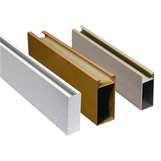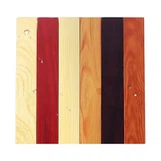Hey there! As a supplier of perforated aluminum veneer, I've seen firsthand how important it is to design these products to withstand strong winds. In this blog post, I'll share some tips on how to design perforated aluminum veneer to improve its wind resistance.
Understanding Wind Forces
Before we dive into the design process, it's essential to understand the forces that wind can exert on perforated aluminum veneer. Wind creates both positive and negative pressures on the surface of the veneer. Positive pressure occurs on the windward side, pushing the veneer towards the building. Negative pressure, on the other hand, occurs on the leeward side, pulling the veneer away from the building. These pressures can cause the veneer to deform, vibrate, or even detach from the building if not properly designed.
Material Selection
The first step in designing perforated aluminum veneer for wind resistance is choosing the right material. Aluminum is a popular choice for veneers because it's lightweight, durable, and corrosion-resistant. However, not all aluminum alloys are created equal. For high-wind applications, I recommend using an alloy with a high strength-to-weight ratio, such as 3003 or 5052. These alloys can withstand the stresses caused by wind without adding excessive weight to the building.
Perforation Pattern
The perforation pattern of the aluminum veneer plays a crucial role in its wind resistance. A well-designed perforation pattern can help to reduce wind pressure on the veneer by allowing air to pass through. This reduces the overall force exerted on the veneer and helps to prevent deformation.
When designing the perforation pattern, consider the size, shape, and spacing of the perforations. Smaller perforations generally provide better wind resistance than larger ones because they create more surface area for the air to pass through. Circular or oval perforations are also more aerodynamic than square or rectangular ones, which can cause turbulence and increase wind pressure.
The spacing between the perforations is also important. If the perforations are too close together, they can block the flow of air and increase wind pressure. On the other hand, if the perforations are too far apart, they may not provide enough ventilation to reduce wind pressure effectively. A good rule of thumb is to keep the perforation spacing between 2 and 5 times the diameter of the perforations.


Thickness and Reinforcement
The thickness of the aluminum veneer is another important factor to consider when designing for wind resistance. Thicker veneers are generally more resistant to wind forces than thinner ones because they have more strength and stiffness. However, increasing the thickness of the veneer also adds weight to the building, which can increase the cost of installation and the structural requirements.
In some cases, it may be necessary to reinforce the aluminum veneer to improve its wind resistance. This can be done by adding stiffeners or ribs to the back of the veneer. Stiffeners are typically made of aluminum or steel and are welded or bolted to the veneer. They help to distribute the wind forces evenly across the surface of the veneer and prevent deformation.
Installation and Support
Proper installation and support are essential for ensuring the wind resistance of perforated aluminum veneer. The veneer should be installed using a secure mounting system that can withstand the forces exerted by wind. This may include using mechanical fasteners, such as screws or bolts, or adhesive bonding.
In addition to the mounting system, the veneer should also be supported by a structural framework. This framework should be designed to distribute the wind forces evenly across the building and prevent the veneer from detaching. The framework can be made of steel, aluminum, or other materials, depending on the specific requirements of the project.
Testing and Certification
Once the perforated aluminum veneer has been designed and installed, it's important to test its wind resistance to ensure that it meets the required standards. This can be done through wind tunnel testing or field testing. Wind tunnel testing involves subjecting the veneer to simulated wind conditions in a controlled environment. Field testing, on the other hand, involves installing the veneer on a building and monitoring its performance during actual wind events.
In addition to testing, it's also a good idea to obtain certification for the veneer from a recognized testing agency. This certification can provide assurance to your customers that the veneer has been tested and meets the required standards for wind resistance.
Conclusion
Designing perforated aluminum veneer for wind resistance requires careful consideration of several factors, including material selection, perforation pattern, thickness, reinforcement, installation, and support. By following these tips, you can ensure that your veneer is strong, durable, and able to withstand the forces of wind.
If you're interested in learning more about perforated aluminum veneer or have any questions about our products, please feel free to contact us for a quote. We'd be happy to help you find the right solution for your project.
References
- Aluminum Association. (2023). Aluminum Design Manual.
- ASTM International. (2023). Standard Test Methods for Determining the Structural Performance of Exterior Windows, Doors, Skylights, and Curtain Walls by Uniform Static Air Pressure Difference.
- International Building Code. (2023). Chapter 16: Structural Design.
Remember, if you're in the market for high-quality perforated aluminum veneer, we've got you covered. Whether you need Hyperbolic Aluminum Veneer, Aluminum Perforated Sheet 1.0mm, or Aluminum Veneer For Ceiling, we can provide the perfect solution for your project. Just reach out, and let's start the conversation!




